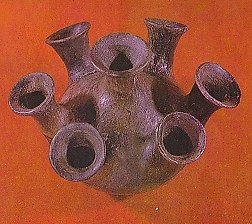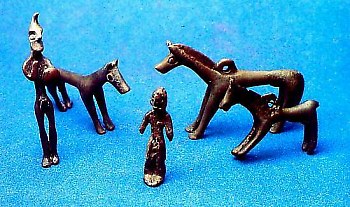By at least 5000 BC, the city-states on the Armenian Plateau had formed a loose federation and extended their influence throughout greater Armenia.
Coming on the wave of the Indo-European migrations into Asia and the Mediterranean, the cultures were in close contact with those that developed in Mesopotamia, sharing ethnic and cultural totems among them. Federations formed and reformed between the "tribes" in the region during most of the Bronze Age. The territory was described as a rich land between the rivers, with their head at the "mountains of the gods" (described as "Arartu" in "Gilgamesh", a ca. 4000 BC Sumerian story, considered the first epoch. In the same epoch the land of Arartu was called the birthplace of humankind, the font of civilization, and to travel there and back, a person had to "go by land, return by water", which perfectly describes the mountainous and river terrain in Armenia).
The Indo-Europeans
Armenian is a separate branch of the Indo-European language family, though it has similarities to languages as far flung as Indian Sanskrit, Persian, Old Greek (Ponti) and Aramaic. The largest of the language families, the Indo-European "tree" is now believed to have sprung from the Armenian Highlands. Developing into sub-branches by around 7000 BC, Indo-European (also known as "Hindo-Aryan") peoples broke off into two main sub-groups: Greek-Armenian and Indo-Iranian. Around 4000 BC, these ethnic groups further subdivided into the Greek-Armenian, Indian Sanskrit, and the Iranian languages.
From there, Indo-Europeans gradually migrated East into Hindistan, South as far as the Persian Gulf, and North to the Aral Sea, where they began a successive series of migrations into Europe. By the time we pick up our story, the Indo-European tree had developed many branches, had borrowed many influences from indigenous groups in the lands where it moved, though key root sounds and words remained.
2000-1800 BC Sumerian clay tablets note migrating peoples from the West who lived with the tribes on the Armenian Plateau. These peoples would have been the migrating Indo-Europeans (including the war-like Hittites), for tablets record such expressions as "we came, we conquered and we captured" as their calling cards.
 The
second wave of Indo-European migration had begun, this time coming full circle
back to the Armenian plateau. Thousands of years of development
created distinct dialects and physical attributes, which further influenced
the "mother tribes" in Armenia.
The
second wave of Indo-European migration had begun, this time coming full circle
back to the Armenian plateau. Thousands of years of development
created distinct dialects and physical attributes, which further influenced
the "mother tribes" in Armenia.
There is a clay tablet written by the Hittites about 2000 BC (discovered in an excavation of the Hittite capital Hatusas--or Boghazkeui-- in N. Central Turkey), which first mentions a tribe of people called Haius, and said they were from the country of Haiassa-Aza. This was a predominant tribe in the region, vassals of the Hittite kingdom, and said to be a distinct Indo-European tribe that introduced its language and customs to neighboring tribes. The Haius were often in rebellion with the Hittites, and they were influential in spreading their culture eastwards, to the peoples on the Armenian plateau. In addition, the architectural and cultural influences of the Hittites were filtered into the region through Haiassa-Aza.
The combination of migrating with native Indo-Europeans was bound to create more than a little cross-fertilization of people, language and ideas, and within the next 1000 years several regional kingdoms using an Indo-European language emerged.
Tribes (or kingdoms, as they were called in historical accounts) in the area included the Mitanni (Southwest of Lake Van and by Lake Sevan), the Hurrian (Sevan), the Manah (around Lake Urmia) and the Diaukhi (around present day Erzurum).
 Mitanni
and Hurrian tribes were dominant on the Armenian Plateau until the mid 2nd
millennium BC. Kurgans (burial mounds) from the 17th-16th
centuries BC have been excavated near Vanadzor uncovering chased gold and
silver cups and bronze weapons. Those from the following period (15th-14th
cc. BC) at L'chashen and in a cemetery at Artik held Mitannian cylinder seals
dating from the final phase of the Mitannian kingdom. After the destruction
of Mitanni by the Hittites at the turn of the 15th-14th
cc. BC, the tribes on the Armenian plateau were nominally under the control
of the Hittites, which had begun to expand into Northern Syria. By the
time the Hittite kingdom fell around 1200 BC, the ancestral Armenian tribes
had forged powerful alliances and were considered a challenge to the northward
expansion of the Assyrians, who became the primary power after the fall of
Mitanni.
Mitanni
and Hurrian tribes were dominant on the Armenian Plateau until the mid 2nd
millennium BC. Kurgans (burial mounds) from the 17th-16th
centuries BC have been excavated near Vanadzor uncovering chased gold and
silver cups and bronze weapons. Those from the following period (15th-14th
cc. BC) at L'chashen and in a cemetery at Artik held Mitannian cylinder seals
dating from the final phase of the Mitannian kingdom. After the destruction
of Mitanni by the Hittites at the turn of the 15th-14th
cc. BC, the tribes on the Armenian plateau were nominally under the control
of the Hittites, which had begun to expand into Northern Syria. By the
time the Hittite kingdom fell around 1200 BC, the ancestral Armenian tribes
had forged powerful alliances and were considered a challenge to the northward
expansion of the Assyrians, who became the primary power after the fall of
Mitanni.
Another migration of Indo-Europeans began in the 12th c BC, at the time of the Trojan War. It concerns the eviction of Thraco-Phrygian tribes (called "foreign settlers") from their native lands by "the People of the Sea" (i.e. early Greeks, Minoans or Mycanaeans). The Thraco-Phrygian moved through the Euphrates into the Armenian Plateau. First inhabiting the land immediately East of the Trojan kingdom in Asia Minor, the Thraco-Phrygians settled on the Western edges of the Armenian plateau and intermingled with the Haiassa-Aza, further developing Indo-European language, culture and physical features.
One of these people's were the forebears of the Urartians, who spoke a distinct language, perhaps borrowed from Assyria and Babylon, but more likely from the Hittites or later Thraco-Phrygian tribes escaping the war at Troy.
Kept up with all this? If you have, then you begin to understand why it has been so hard to trace Armeniaís lineage in the region, and how--with all these tribes inhabiting the same land, more than a little cross-pollination occurred, creating a race of tribes which were all culturally related, sharing language and ethnic roots among them.
And frankly, even the Egyptians and Assyrians were pollinating like bees, being made up of several ethnic groups themselves. Cousins, the tribes in Armenia were still rivals for land and mineral resources, and a few rose to prominence. One of these tribes succeeded in uniting or conquering surrounding city-states into a single empire, which rivaled even the Assyrians and Hittites for power. They were called the Nairi and Urartians by the Assyrians.
Letís put this into perspective and mark ancestral Armenians continuously inhabiting the Armenian Plateau before and throughout the rise and fall of the Old and Middle Kingdoms in Egypt, the entire history of Minoan and Mycanaean cultures (ca 2200-1400 BC), the Indus civilization in present day Pakistan (ca. 2500-1500 BC), the first semi-mythical Hsia (ca 2000-1523 BC) and most of the Shang (1766-1027 BC) Dynasties in China. Greece and Rome are by now a gleam in historians' eyes.